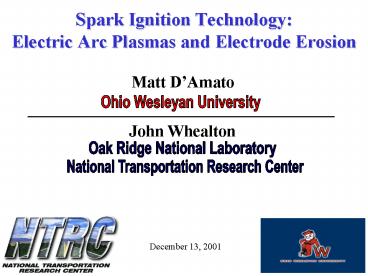Spark Ignition Technology: Electric Arc Plasmas and Electrode Erosion - PowerPoint PPT Presentation
1 / 12
Title:
Spark Ignition Technology: Electric Arc Plasmas and Electrode Erosion
Description:
Spark Ignition Technology: Electric Arc Plasmas and Electrode Erosion – PowerPoint PPT presentation
Number of Views:128
Avg rating:3.0/5.0
Title: Spark Ignition Technology: Electric Arc Plasmas and Electrode Erosion
1
Spark Ignition TechnologyElectric Arc Plasmas
and Electrode Erosion
- Matt DAmato
Ohio Wesleyan University
John Whealton
Oak Ridge National Laboratory
National Transportation Research Center
December 13, 2001
2
Why Are We Interested?
- Applied Science
- Potential for using lean burning fuel mixtures
with rotating arc spark plug - High pressure applications (gt 20 atm) currently
have no spark plug that can last a long time due
to electrode erosion - Basic Science
- Plasma physics and atomic physics involved in
electric discharge
3
Experimental Design
(SmCo Magnets)
Power Supply
Ignition System
(B-field)
-
Spark Plug
Looking for information on two fronts
Erosion/Spectroscopy
Time Evolution/Photography
- High-speed imaging (ns)
- UV/Orange line intensities
- Nanosecond gate width camera used for imaging
spark light with and without a monochromator - Spark may last for 2-3 ms so ns resolution
promises detailed analysis of breakdown, arc,
and glow portions of the discharge
4
(No Transcript)
5
Magnet 1 Hz spark rate 1 ms gate width (longer
exposure captures full arc)
No Magnet 1 Hz spark rate 10 ns gate width (same
over longer exposures)
- Arc with and without presence of 1500 Gauss
- magnetic field along cylindrical axis
- Notice increased area of current sheet (180
degrees)
6
Timing Issues
5
Camera control unit
0
Frame grabber (data acquisition)
Ignition system and spark
- PROBLEM Ideally, one signal triggers all
desired events - SOLUTION Use multi-channel, delayed signal
generator - Accounts for 140 ns delay in camera circuitry
- Allows for minimum 5 ms dwell on spark coil
- Enables data acquisition at typical (30-60 Hz
2k-3k rpm) - and slow (1 Hz) spark rates
- Remember that spark does not occur at the same
time as - the spark gap is varied longer ramp time before
breakdown for larger gaps
7
Spark Gap and Erosion
- Some Considerations
- Conventional plug gap varied from 0.5 mm to 2.5
mm - Spark should contain more energy in larger gaps
- (higher breakdown voltage)
- Erosion analyzed by UV/orange spectral line ratio
- Difficult to balance image gain and intense lines
to obtain desired - signal
- Heat causes problems with resistor plugs and,
possibly, non-resistor - plugs too
8
Clean spark plug -- sanded
9
Three hours after sanding and first test.
10
24 hours after sanding and first test.
11
Basic Physics In Spark Plugs
Faradays Law (for a tightly wound coil of N
turns)
Emf -N(dFB/dt)
Vsecondary Vprimary(Nsecondary/Nprimary)
or, in terms of voltage in coils
Circuit Equations V IR P IV (Energy
transfer) P I2R (resistive dissipation)
Lorentz Force -- Moving charges in a magnetic
field
F q(v x B)
Remember right-hand rule or the F.B.I. for
positive charges
12
Acknowledgements
- John Andriulli, Bill Partridge, Jacob Yoder
- Kaye McGinty and NTRC staff
- This project is funded by the United States
- Department of Energy































